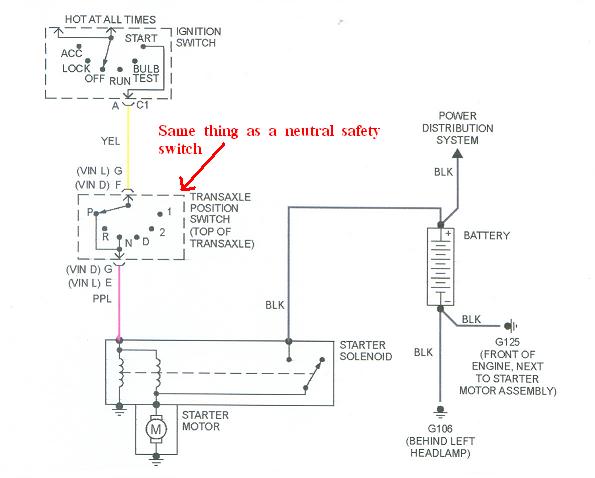|

|
|
battery starter relay? cables?
|
|
|
|  |

|

micho23ldf36
New User
Jan 24, 2007, 7:51 PM
Post #1 of 3
(1889 views)
|
|
battery starter relay? cables?
|
Sign In
|
|
93 chev lumina van 3.1 new batery, good starter and selenoid, car starts sometimes, and most of the time no electrical conection between starter and battery. lights, heter, radio all work. doesn't seem to have any short in system. what do I do?
|
|
|  |

|

tut2261
User
Jan 24, 2007, 8:53 PM
Post #2 of 3
(1883 views)
|
|
Re: battery starter relay? cables?
|
Sign In
|
|
Make sure all your connections are clean and tight.
Just because the starter is new doesn't rule it out.
|
|
|  |

|

DanD
Veteran
/ Moderator

Jan 25, 2007, 6:30 AM
Post #3 of 3
(1879 views)
|
|
Re: battery starter relay? cables?
|
Sign In
|
|
I would begin with making sure power is getting to the purple start wire on the starter’s solenoid. Depending on whether there is or not will determine which direction we’re going in to find the problem.
Here’s how I would do this; it’s simple and only takes a 12-volt clip-on test light.
With a test light clipped to a known good ground and the test light probe touching the electrical connection bolt (purple wire) of the solenoid have someone turn the ignition to the start position. The test light should light; all of this is of course tested when the van is doing its thing of not starting.
If the test light lights then you know that everything from the source (battery), wiring, ignition switch and neutral safety switch are more then likely ok. (See Note #2)
If the test light doesn’t light, I would then move back through the system to the neutral safety switch. There you can test the purple wire the same way as you did at the solenoid; if the light still doesn’t light test the yellow wire in the same manner. The yellow wire is the starter feed wire from the ignition switch.
If still no light, go to the ignition switch, which is located about halfway down the steering column and test the yellow wire there.
There’s more to this but tell us what you have found testing the primary side of the starting circuit and we’ll go from there.
Note: #1 at the neutral safety switch and the ignition switch you may find more then one purple or yellow wire. If so you want to test the one(s) that are of the same gauge (size) of wire that the purple one is at the solenoid.
#2 notice the intensity of the test light it should almost be as bright as if you tested across the battery. If the test light lights during any of your tests but is very dim; then there may be excessive resistance (poor connection) somewhere in the circuit limiting current flow.
To locate the source of this high resistance we would begin doing voltage drop tests between the different components of the circuit to find it. I’ll explain voltage drop tests if need be later, if you haven’t found the problem with the first set of tests.
#3 If you happen to pierce a hole in any of the wire’s insulation during the tests; seal the hole with a little silicone to prevent corrosion.
Dan.


Canadian "EH"
|
|
|  |

| |  |
|


